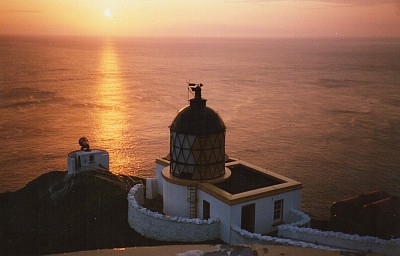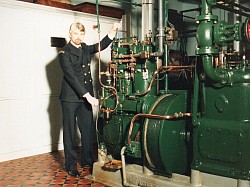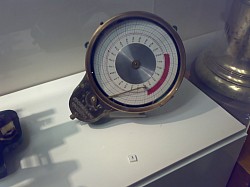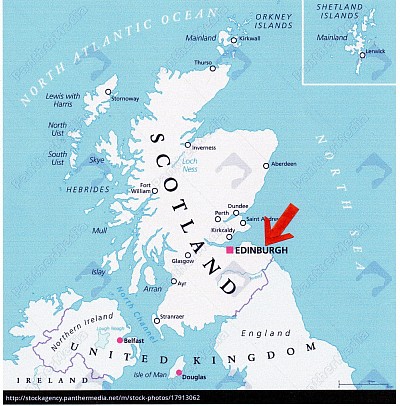St.Abbs Head, Berwickshire
ST ABBS HEAD
The lighthouse stands on a beautiful and interesting part of the Berwickshire coastline with its tall cliffs, home to a thriving bird population with an abundance of Guillemots, Razorbills, Gannets, Fulmars and even the comical Puffins and the walks along the cliffs are quite spectacular, the land surrounding the light is protected by the national trust for Scotland and kept as a wild life reserve, with a warden in attendance, who gives talks and organises nature walks.The lighthouse its self holds little interest except that it has the unusual feature of the tower being situated below the level of the accommodation, so instead of the cry "I'm away up to put the light on" you hear ”I'm away down to put the light on “ The approach road to the light passes by Petticoat Bay which was featured in the movie "Link" you could hardly call the film a blockbuster, but worth a look anyway. Another piece of media interest in the light was from the Halifax building society, for they wanted to shoot part of a TV. commercial there, and head office approved this, So when the big day came to be, lighting trucks, canteen truck and a whole entourage of people arrived, it must have cost the Halifax a fortune for all these bodies and the hire of equipment, anyway the filming went ahead, there were to be two scenes, one using a helicopter hovering over the accommodation block and the other on the stairs leading down to the tower, on either side of the stairs there is a white stone wall and the scene consisted of some one hiding on the other side of the wall and throwing a small grappling hook over the four foot wall and that was it, you only saw the hook coming over in the finished edit, that took an hour or so of takes, one person throwing the hook ,others filming , and not to be missed the all important clapper board man, plus about a dozen others that didn’t seem to be doing much other than drinking coffee, oh yes there is also a a few seconds of the helicopter coming down over the accomodation block.
The advert was shown on TV and on final edit these scenes amounted to several seconds, blink and you would have missed them now I know why it costs so much to make a movie I suppose it keeps people in a job
The view from the watch room was lovely and when on watch at six AM on a nice summers morning with the sun rising, its rays giving the sky an orange hue, the lenticular clouds with there edges glowing, a little fog hanging on the cliff tops and the fishing boats making their way out of Eyemouth Harbour, it had beauty to rival anywhere on earth who could ask for more, Its at these times that you feel very fortunate to be in a position to experience these picturesque scenes. These moments made up for the down sides of the job. As well as sitting in a nature reserve, the sea around the light is also a protected marine reserve, and during the weekends is very popular with sport divers from all around, especially the geordies (Newcastle folk), Newcastle lying only fifty miles south. The currents around the head were treacherous and diving was best carried out at slack water, I’ve seen myself standing on top of the fog tower trying to atract the attention of a inflatable boat to signal that their divers had surfaced several hundred yards down current, the divers frantically waving unseen, on one occasion we had to fire a .22 in the air to attract attention as the divers were getting into trouble, we were on the point of calling the coastguard when fortunately the chap on the boat realised what was happening and speed to the rescue back to the lighthouse.
. Like most, the foghorn was of the compressed air type and powered by three kelvin diesel engines, two providing the necessary power, and one in reserve, the horn was of the low pressure high volume type that worked by the compressed air spinning a siren at the base of the large metal horn and that would in turn start up a resonance or note from the siren, that travelled up through the horn, giving that characteristic low frequency sound, if you were in the horn tower at the time you could feel the vibration go right through your hole body, just like the base beat in modern music only twenty times worse, The character motor which governs the timing of the blasts would frequently stick so you had to go down and free it so the wise thing to do was to escape the tower before the first blast came through, Kelvin engines were started on petrol first and after they were up and running you would throw the lever on the cylinder head to switch over to diesel, these engines were kept immaculately by the keepers and the gleaming brass and copper gave them beauty in a sort of a way, as the station was being automated (as they all were) these engines were normaly just being torn apart and thrown outside for scrap with the rest or the rubbish, it was a sin to see this happening after all these years that the keepers had kept then in minted condition, I wonder how many tins of brasso were laboured upon them, I’m sure that Kelvins profits must have taken a severe dent when the automation was well under way. The principal keeper received a letter from headquarters stating that someone was coming to look at the redundant engines for spares and could we show him around. Well the chap arrived, apparently he ran a few canal boats, that were fitted with kelvins, and he had trouble finding spares for the old engines, Kelvin themselves suggested he contact the lighthouse board as they knew that they were replacing the engines/compressors with electric horns, Anyway we showed the chap into the engine room, and I’m sure I could see his jaw drop as he laid his eyes on these three gleaming works of art sitting in front of him. Never mind spares these engines would be going straight into his boats, and his own would be the ones that would be getting used for bits, and apparently he had secured the kelvins for a song, as the board was just glad to see the back of them and as far as the new owner was concerned he secured the sale of the century.
The light was also very popular with the children from the local school and outings were arranged in the better weather, the children were always very well behaved and appeared interested in the keepers spiel, the kids would enjoy standing around the huge lens, we would (although we were not supposed to) but under supervision let them one at a time stand inside the lens , this was great fun seeing all their friends all distorted, just like being in a hall of funny mirrors. the keepers enjoyed these visits also.
One time we had this foggy afternoon when a military air craft tragically flew into the cliffs somewhere north of us, so we were required to attend the incident rooms temporarily established in Coldingham village hall as we were required to bring all weather recording for that day, we compiled reports for the met office twenty four hours a day at hourly intervals,
St Abbs Head was also used by headquarters in Edinburgh to deal with all out of hours problems we would deal with them and inform the office in the morning of the situation, normally it was a case of a light being reported as extinguished, so the local attendant would be required to verify if possible and the Ministries hydrographer was alerted so that a notice to mariners was broadcast The station also acted as the control station for the Bell Rock, Bass Rock and the Isle of May requiring the keepers to make radio calls three times a day to make sure all was well, the automation control unit for Fidra light on the Firth of Forth was sited at the station also. When on watch during the night you would regularly make rounds of the station to make sure everything was ok and on occasion you could barely make out the silloet of a person standing on the high ground above the station, this is in almost pitch black in the middle of the night why anyone would want to be there beats me. “ there nowt as queer as folk “ as the Yorkshire people would say .




